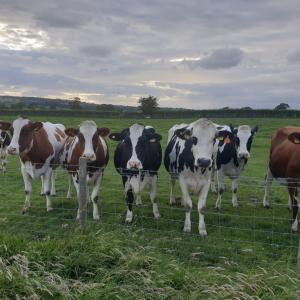
By Vet Annie Kerr
Spring turnout is traditionally the time of year to make sure your herd is fully protected against bovine leptospirosis.
Turnout often heralds the mixing of cattle for the first time and the disease spreads easily between infected and uninfected animals at this time of year.
At grass, uninfected cattle are suddenly exposed to the urine of infected animals that may be shedding. Cows become infected through urine splashing into their eyes, mouth or a cut in their skin. Moist grass is also a relatively favourable environment for leptospira and these organisms generally survive for longer outside the host in mild spring conditions. That’s why the spring is such a peak time for disease transmission.
It is crucial that all at risk cattle are protected for turnout.

Many beef and dairy producers routinely vaccinate against leptospirosis in the spring. If they run open herds the cattle will inevitably become exposed to the disease at some stage as carrier animals are brought in.
Even so-called ‘closed’ herds are at risk if they share watercourses with other herds that are infected. And many who claim they are closed still buy in the odd bull or bargain animal, which of course further exposes them to risk of infection.
Nationally, leptospirosis diagnostic figures as reported by the Schering Plough Animal Health Bovine Leptospirosis Information & Screening Service (BLiSS) continue to show that over 70% of tested unvaccinated cattle herds have been exposed to infection.
Losses from leptospirosis are definitely costly, but not necessarily highly visible.
Whilst the catastrophic face of the disease – abortion storms and milk drop – may not be as prevalent as it once was, the grumbling disease problem – manifesting itself as depressed herd yield, a background infertility problem and weak calves – very definitely is.
It is also worth remembering that abortions can occur up to three months after infection.
It is important to realise that the impaired fertility effect can easily cost a milk producer as much as £100 a cow per year – and that certainly puts the cost of annual vaccination into perspective.
Of equal importance is the fact that bovine leptospirosis is also a nasty zoonotic disease, which can affect farmers, their families, staff and vets – a pretty powerful argument in favour of widespread vaccination.
If you currently run an unvaccinated herd the best policy is to screen for infection regularly using a bulk milk test which avoids the need for blood sampling individual animals. The test will show the level of infection in the herd and provide a starting point for developing a control strategy with your vet. Blood samples are the only option with beef cattle.
For those vaccinating for the first time it is important to plan ahead, as a primary course of two injections, four to six weeks apart, with the second treatment recommended to be carried out at least two weeks before turnout.
In subsequent years only the new crop of youngstock will need two vaccinations so the first dose can be done in advance so that the second can coincide with the main herd booster vaccination.
It is also important to include any stock bulls, and animals bought in during the year should be given a primary course when they join the herd and can then be included in the annual booster vaccination programme.
It is very easy to see vaccination for leptospirosis as yet another cost, especially when the benefits are not immediately apparent. But the payback in improved fertility means most farms cannot afford to leave their herds unprotected. Vaccines used properly are always your cheapest medicines.